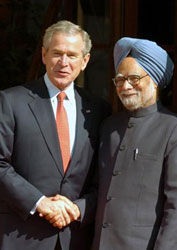NEW YORK - Few places in the world offer as daunting a set of challenges as South Asia. A narcotics-fueled insurgency threatens newly democratic Afghanistan. A resurgent Taliban in its tribal areas has destabilized Pakistan. The recent carnage in Mumbai has prompted another standoff between nuclear-armed India and Pakistan.
Each of these crises calls for urgent action. But as a new Asia Society task force argues, in tackling them the world must not lose sight of the great promise of the India-U.S. relationship.
Today, both countries stand on the brink of an historic opportunity: a new international relationship that will foster global security, stronger economies, nuclear nonproliferation, and progress in combating climate change. But these potential gains will be realized only if US President Barack Obama gives India the attention it deserves, and if both countries broaden the strategic stake by involving their private sectors in issues that governments alone cannot resolve.
 |
| The George Bush -Manmohan Singh handshake that gave a fillip to close US-India ties |
Already, the end of the Cold War and painstaking diplomacy have brought the US-India relationship to a point unimaginable just ten years ago. Both governments now understand each other better, and the two countries' interests are more aligned than they have ever been.
The US presence in Afghanistan highlights the need for stability in South Asia. India's democracy and burgeoning economy make it a major factor in the Asian balance of power, and the recent terrorist attacks in Mumbai underscore a shared struggle against violent Islamic extremism.
The recent civil nuclear agreement between the two countries paves the way for cooperation in halting the spread of nuclear weapons. At the same time, bilateral trade has soared to more than $40 billion in 2008, from about $12 billion in 1998. Even where the two governments continue to disagree - for example, on the Doha round of trade negotiations and on the solution to climate change - the potential for new and creative cooperation outweighs their differences.
To begin with security, India is a vital piece of the puzzle on questions of stability in Afghanistan and the balance of power in Asia. On global nonproliferation, the US should push for a role for India in next year's Nuclear Non-Proliferation Treaty (NPT) review conference in order to complete the country's transformation from being part of the problem to being part of the solution. In terms of counterterrorism, the tragic events in Mumbai present an opportunity to ratchet up intelligence sharing, joint response training, and personnel exchanges to defeat the defining threat of our times.
Over the past decade, economics has pulled the US and India closer. It will continue to power the relationship in the future, even as both countries experience a slowdown during the current economic crisis. The US should tap India's potential as an engine for economic recovery, and consult much more closely with it on matters of finance, trade, and investment. In the long run, a global trade agreement will not be completed without India's engagement. By getting India into the G-8 and other multilateral institutions, the US can ensure that India's growing role in the world carries commensurate responsibilities.
Beyond government cooperation, the creativity and dynamism of businesses, NGOs and private citizens in both countries hold the key to what India and the US can offer each other and the world. Obama should tap the expertise and energy in the Indian and American private sectors to foster public-private partnerships on complex global problems such as climate change, agricultural transformation, education and HIV/AIDS.
Consider climate change. Without India, it is hard to imagine a successful conclusion to the 2009 Copenhagen conference to draft a successor agreement to the Kyoto Protocol. Reaching an agreement will require tough diplomacy, difficult compromises, technological innovation, and changes to our carbon-intensive way of life.
India and the US are natural partners in meeting this challenge, with innovative scientists and venture capitalists who can take technology breakthroughs from the lab to the market, and NGOs with vast grassroots conservation and public advocacy experience. Similar coalitions can be assembled to dent global poverty by fostering a second green revolution in Indian agriculture, to enhance India's role in the global economy through vocational and higher education, and to tackle the worldwide spread of AIDS.
For too long, the world's oldest and largest democracies have failed to fulfil the promise of their relationship. But if Obama seizes what we believe is a rare historic opportunity this could change decisively - for the long-term benefit of America, India, and the world.
* Frank G. Wisner was US Ambassador to India from 1994-1997; Charles R. Kaye is former Chairman of the US-India Business Council and Chairman of the Asia Society; Vishakha N. Desai is President of the Asia Society; and Alyssa Ayres is director for India and South Asia at McLarty Associates.
Copyright: Project Syndicate, 2009. Exclusive to The Sunday Times |

